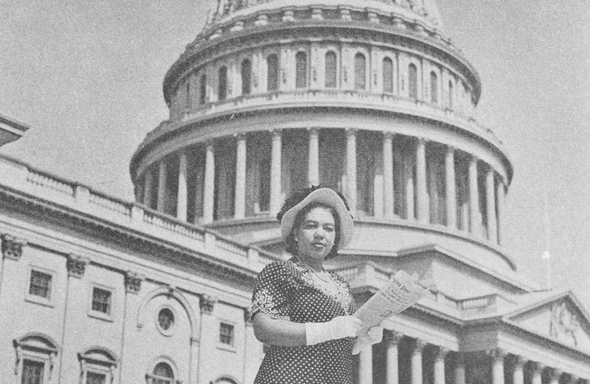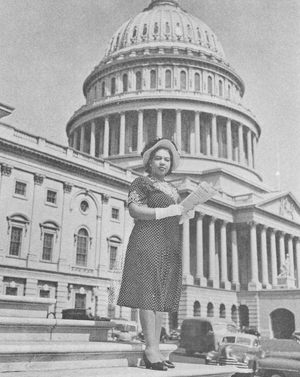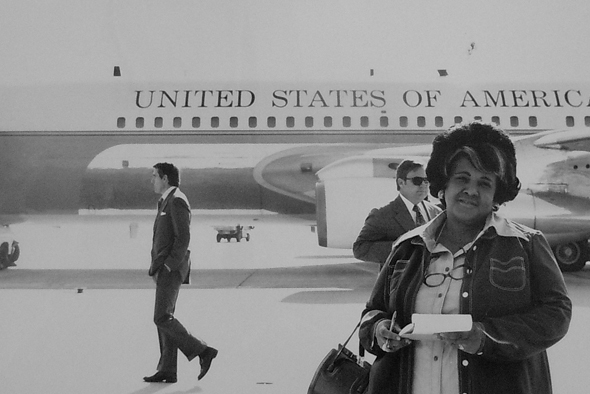
Alice Dunnigan and Ethel Payne were the first two African American women to hold White House press passes. They fought their way in to cover some of the biggest events of their times despite the one-two punch of sexism and racism that pervaded the corps, and society at large. Though much has changed since Dunnigan first obtained her pass in the Jim Crow 1940s, many of today’s issues–#blacklivesmatter; glass ceilings–would be all too recognizable to her and Payne. Books about both women are coming out next week: a new edition of Dunnigan’s memoirs on Feb. 15, and a biography of Payne two days later. Both are excerpted below.
Two years after Alice Dunnigan was inducted posthumously into the Black Journalists Hall of Fame, the University of Georgia Press is publishing Alone atop the Hill (Feb. 15), a new, annotated edition of her 1974 autobiography. Cited for more historic “firsts” than any other journalist of her time, Dunnigan asks to be judged by the depths from which she rose, rather than her lofty accomplishments, which were considerable: first black female journalist accredited to the House and Senate Press Galleries, the White House, and the Supreme Court, and the first to travel with a US president–Harry S. Truman, on his 1948 whistle-stop tour of 18 Western states.
Credited with having paved the way for every black woman who has since covered the White House, Dunnigan did more to keep black Americans informed about the struggle for civil rights than any other journalist of her era, the decade before the movement exploded on the front pages of the mainstream press. With unprecedented credentials for a black journalist, and more so a female, she pressed on for 14 years, reporting on the raw politics of a nation in the early stages of a racial upheaval for the Associated Negro Press’ 112 black newspapers across the United States and more than a dozen in the emerging nations of West Africa, while blazing her own trail into history. In this excerpt from her memoir, she recounts the struggle to obtain her Senate credentials.
–Carol Booker, editor

I began my job as chief of the Washington Bureau for the Associated Negro Press on the first day of January 1947. My first assignment was to cover the potential ouster of Theodore Bilbo of Mississippi from the US Senate for misconduct. I was fairly familiar with legislative procedure and with the Capitol building, having often lobbied with a delegation from the Southern Conference for Human Welfare for passage of anti- poll-tax legislation and an antilynching law, two bills of major concern to that organization. But I knew nothing of press operations on Capitol Hill.
On the opening day of Congress, I secured from my Kentucky senator a pass admitting me to the visitors’ gallery. Upon arrival, I found a long line waiting for seats in the already overflowing gallery. For hours I stood in this line, which moved only when a few people left the gallery, making room for a few others. I became very disgusted and anxious to get inside so that I could get to work on my assignment. I was completely unaware that it was against Capitol rules for spectators to take notes in the visitors’ gallery. When I discovered this, I realized that the visitors’ gallery was not an appropriate place for reporters, anyway.
While standing in line, I noticed a number of newsmen entering and going up a back stairway that was securely roped off with the usual red velvet ropes so commonly seen in places of dignity around the nation’s capital. This stairway was guarded by Capitol police. The reporters would step up, show their passes, and be admitted. I saw no reason why I shouldn’t do that. So I stepped up to the stairway, only to be stopped by the guards and asked where I was going.
“I’m a newspaper reporter,” I explained, “and I’m going wherever those newsmen are going.”
“But this is reserved only for reporters of accredited newspapers,” one policeman replied.
“I’m a reporter for an accredited news bureau,” I argued, proudly producing my newly acquired ANP press pass for inspection.
“Even with that,” the other guard chimed in, “I don’t think you belong up there. But I’m going to let you through. If you have no business up there, they’ll send you back, anyway.” With this he unsnapped the rope and allowed me to pass.
At the top of the steps, I opened a door marked “Press Gallery” and walked in. To my surprise, I was in a large suite of rooms completely equipped with all types of apparatus needed by reporters. There were rows of typewriters and shelves filled with reference books, dictionaries, and congressional registers covering many years. A Western Union machine was ticking away in one corner of an adjoining room. One whole wall was lined with telephone booths. Through an open door, I could see another room full of radio and television equipment. Still another room was furnished with comfortable couches and easy chairs for relaxation.
‘I don’t think you belong up there. But I’m going to let you through. If you have no business up there, they’ll send you back, anyway.’
Press releases were piled high on a little table, surrounded by stacks of copy paper, carbon paper, Western Union blanks, letterheads, and envelopes. The main door led into the gallery overlooking the Senate chamber. Rows of circular seats were provided for reporters to watch the Senate in action. This is indeed a reporter’s haven, I thought, as I gazed around in awe.
Suddenly I was facing a gallery official who politely asked if there was anything he could do for me.
I explained that I was a reporter assigned to the Bilbo hearing and wanted only to see what was going on inside the Senate chamber.
“No one can observe from the gallery except accredited Capitol reporters,” the man explained.
“What does one have to do to become an accredited Capitol reporter?” I asked.
Without specifically answering my question, the official stated that they were not accrediting any more reporters because they already had more members than they could accommodate in that space.
“Are there any Negro reporters accredited?” I asked.
He gave a negative answer, explaining that there were certain qualifications. If a reporter met those qualifications, he could apply for membership. His application would be reviewed by the standing committee of the gallery, and if it met the requirements, his membership would be approved by the committee.
I asked for and received an application, which I later completed and submitted.
Weeks passed, and I received no word regarding my application. When I called about it, I was told that the standing committee had not yet acted on it. After more weeks passed, I called again and received the same answer. After a while, I began to make personal visits to the Capitol to inquire about the status of my application, probably making a nuisance of myself. Finally I was informed that I did not qualify for membership since applicants were required to represent daily papers.
To pacify me, I was given another application for membership in the Periodical Gallery. I submitted it and ultimately was notified that I did not qualify for membership there because that gallery, they said, was exclusively designed for magazine writers and I was representing weekly newspapers.
The fight for membership continued, with various organizations and the newspaper guild getting into the act. After a time, the Senate Rules Committee, chaired by Illinois Republican senator C. Wayland (Curley) Brooks, held hearings on the matter. The upshot was the committee ordering that the rules of the gallery be changed to admit representatives of news agencies.

In this excerpt from Eye on the Struggle by James McGrath Morris (Amistad/Harper, Feb. 17), Ethel Payne had been working as a reporter for less than three years when she found herself a member of the Washington Press Corps. What she discovers, in this and other moments, is that the power she now possesses to ask questions at national press conferences could put issues of civil rights on the national agenda. Specifically, in this moment, she is heading to a press conference to ask President Eisenhower about an incident that had not appeared in the mainstream white media. As a result of her questions, the story made The New York Times and other papers, including the Washington Post, which prided itself on its local coverage yet missed or ignored the incident.
On the morning of February 10, 1954, Ethel Payne made her way across Washington to the Executive Office Building, a massive gray stone structure adjacent to the White House that had once housed the entire Departments of State, War, and the Navy. Under a cloudy sky, the temperature would hardly reach the 40s that day, but Payne was seething.
Five days earlier the choir from Howard University, the capital’s historically black college, had been asked to perform, along with singers from Duke and Emory Universities, at the annual Lincoln
Day Dinner held by Washington Republicans. Happy at long last to have one of their own in the White House, about 8,000 Republicans crowded into the Uline Arena, a cavernous vaulted hall named for an ice mogul. When the two Southern white choirs reached the entrance, they traversed the security cordon without any delay. But when the bus carrying the Howard choir arrived, the police refused to let it pass.
The officers insisted that the bus had to come in through a different entrance, so the driver obediently pulled around to the other side of the building. Once again it was blocked from entering. The dean of the university’s school of music, who had accompanied the students, agreed to wait while a police officer went to talk with an event organizer. But during the first officer’s absence, another policeman ordered the bus to move immediately because the president’s limousine was expected at any minute. The dean’s patience ran out. He instructed the driver to take the choir back to the university.
The exclusion of the black singers, unreported in the press, wasn’t the only aspect of the celebration that had gotten under Payne’s skin over the weekend. In putting together a program to honor the great emancipator, the Republicans had included Jack Powell, an aging white vaudeville actor with a minstrel routine. Powell came onstage dressed in a cook’s outfit, in blackface, and wearing a wig of kinky hair. According to the announcer, the actor was included in the program by special request of Sherman Adams, Eisenhower’s chief of staff. The morning after the event, Payne fired off a telegram to Adams. “Surely,” she wired, “there could have been some representation of the Negro people on such an occasion more dignified and in keeping with the progress of the race.”
Now, heading to the Executive Office Building, Payne planned to take up the matter with Adams’ boss. At 10:30 am, Eisenhower was set to hold his 27th press conference of his administration. Since her arrival in Washington three months earlier, Payne had yet to ask a question at a presidential press conference. Today she was going to make sure she did.
A dark-skinned visitor’s best chance at obtaining lodging in a hotel was to wrap his head in a turban and register using a foreign name, according to a report on segregation in Washington.
A few months earlier, when editor Louis Martin asked Payne if she wanted to go to Washington, he had been motivated by more than a desire to retain a star reporter who was feeling unappreciated. The skinflint newspaper had lost its Washington correspondent to a better-paying job and Payne’s unhappiness was an opportunity for the [Chicago] Defender. “Go on down to Washington and try your hand,” Martin told Payne. “If you don’t like it, come on home after six months.” He was hedging his bet. By giving Payne the option of coming home, he preserved for himself the excuse to bring her back if her work did not measure up.
Since the end of World War II, the Defender had continuously maintained at least a part-time correspondent in the capital. Some had been government employees, like Al Smith, who wrote a column under the pen name Charlie Cherokee. In recent years, Venice Tipton Spraggs, a tall, striking woman with prodigious work habits, had ably served the paper. But she had taken a job with the Democratic National Committee, leaving the Defender bereft of representation in Washington, DC.
With the fanfare of a front-page story, the paper announced, “Miss Ethel Payne, one of the Chicago Defender‘s crack news and feature writers, has been assigned to Washington.” Publisher John Sengstacke sung her praise. “We purposely waited to fill the Washington assignment in our organization until we were satisfied that we had a person capable of doing the same superb job of giving our readers the most accurate coverage possible of the Washington scene in the same excellent manner as Mrs. Spraggs and Al Smith who preceded her,” he said, giving the appointment the sheen of forethought.
If the segregation still prevalent in Chicago had been a jarring readjustment for Payne upon her return from Japan, Washington had worse in store for her. By constitutional designation, the city was the nation’s capital. In all other respects, from the Southern congressmen who ruled over the powerless federal enclave down to school officials and city administrators, it was a Southern town through and through, with an approach to racial matters not unlike that prevalent in Atlanta, GA, or Richmond, VA.
E. Frederic Morrow, a black Republican who had worked for both the NAACP and CBS, was also moving to Washington at the time. He had served as the liaison between the black community and
the Eisenhower campaign in 1952 and had been promised a White House job. He found white cabbies would not pick him up, restaurants would not serve him, and hotels had no rooms. A dark-skinned visitor’s best chance at obtaining lodging in a hotel was to wrap his head in a turban and register using a foreign name, according to a report on segregation in Washington. “This maneuver was successfully employed not long ago at one of the capital’s most fashionable hotels by an enterprising American Negro who wanted to test the advantages of being a foreigner.”
In late November, after unpacking her belongings in a flat on Vernon Street in a black neighborhood in northwest Washington, Payne went to call on Spraggs. “I felt like a child trying to step into grownup’s shoes,” said Payne. The seasoned correspondent received her warmly and, over home-cooked meals, provided her with an introductory course in the ways of Washington. Unlike many other correspondents sent to Washington, Payne did not feel it was beneath her to take lessons. Her insecurity about reporting on national affairs after only a couple of years of local reporting left her open to sage advice. It also permitted her to consider Washington events with a fresh perspective. From Chicago, city editor Enoch Waters praised her early work in Washington and spurred her onward. “Of course it did not measure up to the standard of which you are capable,” he wrote. “Keep up the good work old girl and remember everybody here is pulling for you.
The Editors are the staffers of the Columbia Journalism Review.
